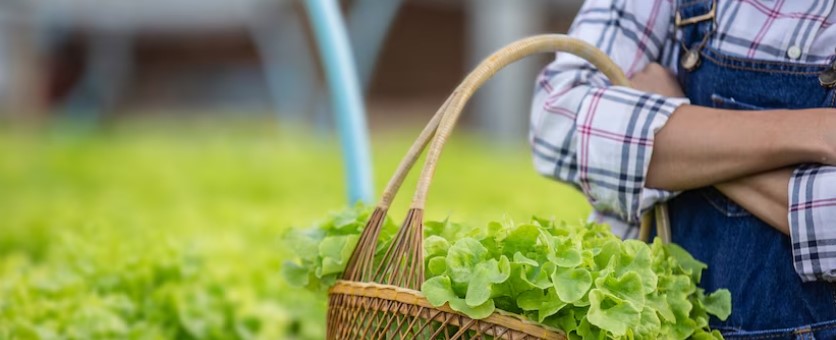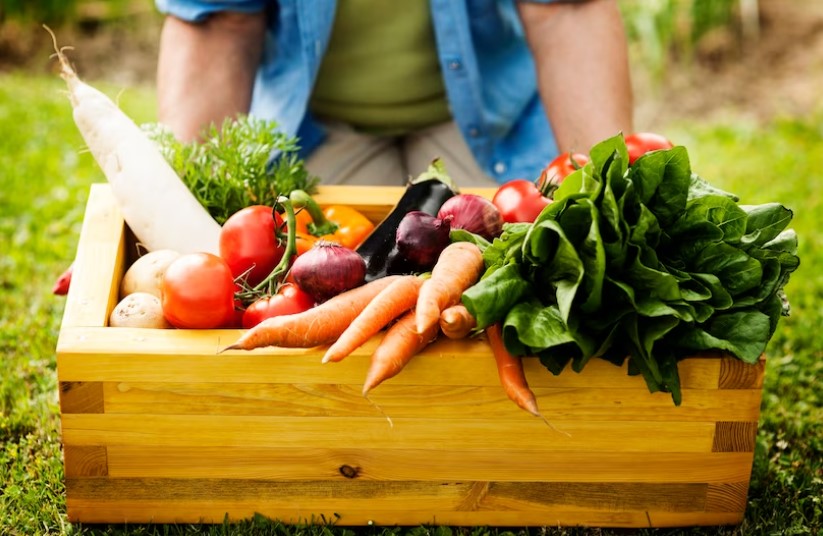Gardening is a great way to not only enjoy the outdoors, but also to grow your own fresh, nutrient-dense food. Whether you have a large plot of land or just a small balcony, growing your own food is a rewarding and healthful pursuit. With so many options available, it can be challenging to determine the best foods to grow in your garden.
This article will explore the top foods that you can grow in your garden for optimal health, taking into account factors such as ease of growth, nutritional value, and year-round availability. From leafy greens and root vegetables, to fruits and herbs, these foods will not only provide you with essential vitamins and minerals, but also help you achieve a healthy, balanced diet.
By incorporating these foods into your daily routine, you can take control of your health and support your overall well-being.
I. Leafy Greens

Growing your own garden and incorporating leafy greens into your diet can greatly enhance your health and well-being. Leafy greens, such as kale, spinach, and lettuce, are nutrient-dense and low in calories, making them a great addition to any healthy diet. In addition to being rich in vitamins and minerals, leafy greens also contain antioxidants and phytochemicals that can help protect against a range of health problems, including heart disease, cancer, and cognitive decline.
Kale is one of the most nutrient-dense leafy greens, with high levels of vitamins K, A, and C, as well as fiber and iron. Spinach is also a great option, with high levels of vitamins A and C, folate, and iron. Lettuce is a versatile green that can be added to salads, sandwiches, or used as a wrap for fillings. There are many different types of lettuce, each with its own unique flavor and texture. Some of the best lettuce varieties for gardening include Butterhead, Romaine, and Iceberg.
When growing leafy greens, it’s important to choose the right type for your garden based on your climate and soil conditions. Kale, for example, prefers cool weather and well-drained soil, while spinach grows best in cooler temperatures. It’s also important to water regularly and provide adequate sunlight, as leafy greens need plenty of water and light to grow.
Harvesting leafy greens can be done by removing individual leaves as needed or by cutting the entire plant when it reaches maturity. It’s best to harvest in the morning, as the leaves will be more nutrient-dense and flavorful.
In conclusion, growing your own leafy greens in a garden is a simple and cost-effective way to enhance your health and well-being. With a variety of greens to choose from, including kale, spinach, and lettuce, there’s sure to be a green that fits your taste and growing conditions. By incorporating these nutrient-dense greens into your diet, you can improve your overall health and enjoy the many health benefits they provide.
II. Berries

Growing your own garden and incorporating leafy greens into your diet can greatly enhance your health and well-being. Leafy greens, such as kale, spinach, and lettuce, are nutrient-dense and low in calories, making them a great addition to any healthy diet. In addition to being rich in vitamins and minerals, leafy greens also contain antioxidants and phytochemicals that can help protect against a range of health problems, including heart disease, cancer, and cognitive decline.
Kale is one of the most nutrient-dense leafy greens, with high levels of vitamins K, A, and C, as well as fiber and iron. Spinach is also a great option, with high levels of vitamins A and C, folate, and iron. Lettuce is a versatile green that can be added to salads, sandwiches, or used as a wrap for fillings. There are many different types of lettuce, each with its own unique flavor and texture. Some of the best lettuce varieties for gardening include Butterhead, Romaine, and Iceberg.
When growing leafy greens, it’s important to choose the right type for your garden based on your climate and soil conditions. Kale, for example, prefers cool weather and well-drained soil, while spinach grows best in cooler temperatures. It’s also important to water regularly and provide adequate sunlight, as leafy greens need plenty of water and light to grow.
Harvesting leafy greens can be done by removing individual leaves as needed or by cutting the entire plant when it reaches maturity. It’s best to harvest in the morning, as the leaves will be more nutrient-dense and flavorful.
In conclusion, growing your own leafy greens in a garden is a simple and cost-effective way to enhance your health and well-being. With a variety of greens to choose from, including kale, spinach, and lettuce, there’s sure to be a green that fits your taste and growing conditions. By incorporating these nutrient-dense greens into your diet, you can improve your overall health and enjoy the many health benefits they provide.
III. Tomatoes

Tomatoes are one of the most popular and widely grown fruits in home gardens. They are not only delicious, but also packed with essential vitamins, minerals, and antioxidants that are essential for a healthy diet. From juicy heirloom tomatoes to sweet cherry tomatoes, there are many varieties to choose from that can add color, flavor, and nutrition to your meals. In this article, we will discuss the health benefits of tomatoes, provide tips for growing and caring for tomato plants, and introduce different types of tomatoes to grow and their unique benefits.
Tomatoes are an excellent source of vitamin C, which is essential for boosting the immune system, promoting skin health, and protecting the body against harmful free radicals. They are also rich in vitamin A, which helps maintain good vision, skin, and immune system health. Additionally, tomatoes are a good source of lycopene, a powerful antioxidant that has been linked to reducing the risk of cancer, heart disease, and other chronic conditions. Furthermore, tomatoes are low in calories and high in fiber, which makes them a great choice for anyone trying to maintain a healthy weight or improve digestive health.
Tomatoes are relatively easy to grow, but there are a few tips you can follow to get the most from your plants. Firstly, it is important to choose a sunny spot in your garden with well-drained soil. Tomato plants require at least six hours of direct sunlight each day. Secondly, water your plants regularly and deeply, especially during dry spells. Tomatoes also require proper nutrition, so consider adding compost or fertilizer to your soil to ensure they receive the nutrients they need to thrive. Lastly, prune your plants regularly to remove any diseased or yellow leaves, and to encourage more fruit production.
There are many different types of tomatoes to choose from, each with its own unique flavor, texture, and nutritional profile. Some of the most popular varieties include:
- Heirloom Tomatoes: Heirloom tomatoes are open-pollinated and come in a variety of colors, shapes, and sizes. They are known for their unique flavors and are often sought after by home gardeners for their sweet, juicy taste.
- Cherry Tomatoes: Cherry tomatoes are small, round, and sweet. They are a great choice for snacking and are easy to grow in pots or containers.
- Beefsteak Tomatoes: Beefsteak tomatoes are large, juicy, and meaty. They are perfect for slicing and using in sandwiches or salads.
- Roma Tomatoes: Roma tomatoes are small, oblong, and fleshy. They are a great choice for sauces and canning, as they have a low moisture content.
- San Marzano Tomatoes: San Marzano tomatoes are a type of roma tomato that is famous for its use in Italian cuisine. They are known for their sweet and tangy flavor, making them a great choice for sauces, soups, and stews.
In conclusion, tomatoes are a delicious and nutritious fruit that are easy to grow and care for in a home garden. Whether you prefer heirloom tomatoes, cherry tomatoes, or roma tomatoes, there is a variety to suit everyone’s taste. By following the tips for growing and caring for your tomato plants, you can enjoy a bountiful harvest of fresh, juicy, and nutritious tomatoes all season long.
IV. Root Vegetables

Growing your own food is a great way to ensure you have access to fresh, healthy produce. One type of food that can be easily grown in a garden is root vegetables. Root vegetables, such as carrots, beets, and radishes, are not only delicious but also packed with essential vitamins and minerals that are important for overall health. In this article, we will discuss the health benefits of root vegetables, provide a list of the best root vegetables to grow in your garden, and offer tips for growing and harvesting these nutritious vegetables.
Root vegetables are a great source of vitamins and minerals, including vitamin C, potassium, and iron. They are also low in calories and high in fiber, making them a great choice for those looking to maintain a healthy weight. Additionally, root vegetables are packed with antioxidants, which help to protect the body from free radical damage and reduce the risk of certain diseases, such as cancer and heart disease.
There are many different types of root vegetables that can be grown in a garden, but some of the best include carrots, beets, and radishes. Carrots are not only tasty, but they are also high in vitamin A, which is essential for good vision and skin health. Beets are a great source of folate, which is important for cell growth and development, and they also contain antioxidants that help to reduce inflammation in the body. Radishes are a great source of vitamin C, which is essential for boosting the immune system, and they are also low in calories and high in fiber, making them a great option for those trying to maintain a healthy weight.
Growing root vegetables is relatively easy and can be done in a variety of soil types. It is important to choose a sunny location with well-drained soil for growing these vegetables. Before planting, amend the soil with compost or other organic matter to help improve fertility and water retention. When planting, be sure to follow the recommended planting guidelines for each type of root vegetable, as some may require deeper planting depths than others.
Regular watering is important for root vegetables to ensure they have access to the moisture they need to grow. In addition, mulching around the plants can help to conserve moisture and suppress weed growth. When it comes to harvesting, be sure to wait until the vegetables are fully mature and have reached their maximum size. This will ensure the best flavor and nutritional value.
In conclusion, root vegetables are a great option for those looking to add more nutritious foods to their diet. They are easy to grow in a garden, and they provide a variety of health benefits, including vitamins, minerals, and antioxidants. Whether you are growing carrots, beets, radishes, or any other type of root vegetable, be sure to follow the tips outlined in this article to ensure a successful harvest. With a little care and attention, you can enjoy fresh, nutritious root vegetables straight from your own garden.
V. Herbs

Herbs are not just used to add flavor and aroma to dishes, they also offer numerous health benefits. From boosting immunity to reducing stress and improving digestion, growing herbs in your garden can greatly enhance your overall well-being. In this article, we will discuss the health benefits of herbs and provide a list of the best herbs to grow in a garden, along with tips for growing and harvesting them.
Herbs are packed with essential vitamins, minerals, and antioxidants that can have a positive impact on our health. For example, basil is a great source of vitamin K and magnesium, while mint contains high levels of vitamin C and manganese. Parsley is rich in vitamins A and C, and has been shown to have anti-inflammatory properties.
Growing herbs in your garden is a great way to have fresh, organic, and easily accessible ingredients to add to your meals. In addition, growing your own herbs can save you money, as herbs from the store can be expensive. It is also a great way to be more environmentally friendly by reducing the carbon footprint of shipping and packaging.
Here is a list of the best herbs to grow in a garden:
- Basil: A warm weather herb that can be grown in pots or in the ground, basil adds a sweet and fragrant flavor to dishes like pasta sauces and salads.
- Mint: This hardy herb can be grown in pots or in the ground, and has a wide range of uses in cooking and baking.
- Parsley: This versatile herb can be used in a variety of dishes and has a fresh, slightly bitter flavor.
- Rosemary: This woody herb is great for adding flavor to meats and vegetables, and can also be used in teas and soaps.
- Thyme: This herb has a strong, slightly sweet flavor that is great for seasoning poultry and fish.
When growing herbs, it is important to make sure that they have access to plenty of sunlight and water. Herbs also benefit from regular pruning, as this helps to encourage bushy growth and prevent them from becoming leggy. It is also important to make sure that the soil you are using is well-draining, as herbs do not like to be in standing water.
Harvesting herbs is a simple process that can be done by snipping off the leaves as needed. It is best to harvest herbs in the morning, when the oils are at their strongest, and to avoid harvesting more than one-third of the plant at a time. This will help to ensure that the plant continues to thrive and produce new growth.
In conclusion, growing herbs in your garden is a great way to improve your health and enjoy fresh, organic ingredients in your meals. Whether you are growing basil, mint, parsley, rosemary, or thyme, there are a variety of benefits to be gained from these flavorful and aromatic plants. With a little care and attention, you can have a thriving herb garden that will provide you with all the health benefits that herbs have to offer.
Conclusion
In conclusion, growing your own garden can be an incredibly rewarding experience that offers numerous health benefits. Whether it’s leafy greens, berries, tomatoes, root vegetables, or herbs, each type of food has its own unique set of benefits and growing requirements.
By choosing the right types of plants and following proper care and growing techniques, you can enjoy fresh, healthy, and delicious food right from your own backyard.
Not only does this help you maintain a healthy diet, but it also gives you the satisfaction of knowing exactly where your food comes from and how it was grown. Whether you’re a seasoned gardener or a beginner, incorporating these foods into your garden is a great way to promote optimal health and wellness.



